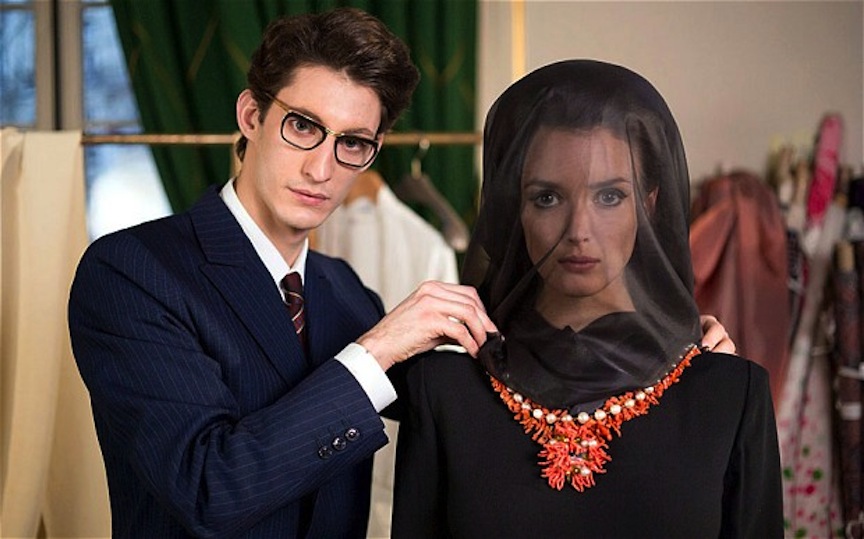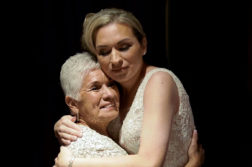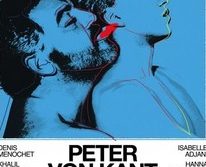 Yves Saint Laurent
Yves Saint Laurent
Directed by Jalil Lespert
ONE OF THE PITFALLS of the biopic is the lead actor’s temptation to do a full-throttle imitation of the person whose life story is being told. Unless you’re Meryl Streep channeling Margaret Thatcher or Julia Child, or Marion Cotillard as Edith Piaf, the results can seem like bad parody. A recent entry to the genre is the French film Yves Saint Laurent about the young French Algerian genius who at 21 took over the haute couture house of Christian Dior, and the performance by the young Pierre Niney as Saint Laurent has to enter the annals of great star-making turns. Niney, a stage actor with the renowned Comédie Française, gives us a richly layered, three-dimensional portrait of the intensely shy Yves Saint Laurent, a gay prince from a family of the haute bourgeoisie in Oran who came of age as the Algerian war for independence was taking root.
Saint Laurent’s rapid ascent in the Parisian fashion world is seen as the result of his intense inner drive and confidence in his own talents, given public voice in his early press interviews. He makes good with the crucial help of Pierre Bergé, his lover, mentor, companion, and soul-mate. In real life, Bergé was Yves’ senior by only six years but was by temperament far more stable and acted as something of a father figure. Together the two men would build the YSL fashion empire.
Two early moments set the stage for an understanding of the young genius’s psychology. In 1960, Saint Laurent is drafted into the army at the time of the Algerian War, an eventuality he has feared and for which he is temperamentally unsuited. And we know why: a sensitive and creative gay man, almost painfully shy, will be asked to hold a gun and make war. Almost immediately, he suffers a nervous breakdown and enters a military hospital. Bergé goes off to attend to his lover, who has shriveled to a shadow of his former self, turning his face to the wall and barely eating. A diagnosis of manic depression facilitates his departure from military service. In the meantime, the house of Dior has fired Saint Laurent since, in his mental state, he’s not capable of working, although this is merely a screen for the administration’s loss of confidence in his talent: after a wildly successful first-season launch, his work had not fared as well in the next two shows.
Again, Bergé takes the reins, suing Dior for a considerable sum and amassing the financial support for Saint Laurent to strike out on his own with a line of haute couture. This second “crisis”—an attack upon his competence and fledgling reputation—reveals how the young YSL, obsessed with nothing but his design abilities, his compulsion to create women’s clothes at the highest artisanal level, is also a reflection of his total inability to live in the quotidian world. YSL admits to being a “cripple”; he’s the sort of childlike genius who can do one thing brilliantly but cannot otherwise function in daily life.
The rest of the film is an unusually compelling account of professional triumphs played against fitful descents into the drug and sex hedonism of the 1970s, revealing and opening the divide between the YSL and Bergé. The former, having led a monkish existence while attending to the grueling requirements of spring and fall runway shows, now surrenders to the teenage rebellion he never experienced. The lovers’ vacation house in Marrakech becomes the headquarters for young friends and close colleagues who share sexcapades, jokes, and cocaine. Bergé, who has already shown himself capable of tactical infidelity—screwing a favored (female) runway model who is Saint Laurent’s chief “muse” in order to arouse his partner’s jealousy—now must forbear a series of bacchanals which draw the flailing Yves deeper into guilt, defensiveness, and substance abuse.
Jalil Lespert, the film’s director and writer, has a shrewd eye for capturing period detail of the Paris fashion world. The early scenes of the Dior era portray a demanding backstage calculus and a prim—one would say almost conventional—public face where runway shows were strictly reserved for the elect few to be seated close to the action. The models would present in a series of regimented poses and quick whirls with nothing left to chance. Later, and much under YSL’s own influence, runway shows would become extravaganzas, veritable light-and-sound shows with the fashion press eagerly priming the public relations pump.
Lespert, himself a successful film actor, has populated his film with excellent players at all levels. Guillaume Gallienne, another Comédie Française alum, portrays Bergé as the calm captain in the center of the storm—until he himself, at moments of stress, erupts. As YSL’s early muse Victoire, Charlotte Le Bon creates a fashion model who is both beautiful and intelligent, supportive of the enfant terrible who is her boss and friend—and who briefly, improbably proposes marriage.
The film is peopled by a colorful sampling of fashion’s now iconic characters—everyone from Karl Lagerfeld to Loulou de la Falaise. Even the aging Jean Cocteau makes an appearance in an early Dior-period scene, and we can’t help but suspect that the young man with the full head of platinum hair lounging on the cushions of the Marrakech home is meant to suggest Andy Warhol. As a contrast to the staid conventions of the 1950s, the late ’60s and ’70s scenes throw us into a corner of bohemian privilege likewise threatened by the period’s left-wing revolutionary fervor.
Pierre Niney gives an outsize performance. Saint Laurent was hardly a heartthrob; his heavy black frame glasses gave him a nerdy demeanor. Niney, slender and doe-like, has a face that, in a woman, the French would call jolie laide—a slightly “off” quality that lends its owner an atypical beauty, an attraction that goes beyond conventional categories. Niney’s physical appeal is just that—and his performing arc from timidity to strength of will, from awkward public player to private and endearing friend, from passionate young lover to mature cynic—is a fascinating account of a quiet genius at war, first with himself and then with public expectations. Like the aria from La Wally that underscores one of the designer’s greatest runway triumphs, Yves Saint Laurent is operatic in its emotional temperatures. Go get scalded.
Recently shown at the Provincetown International Film Festival






